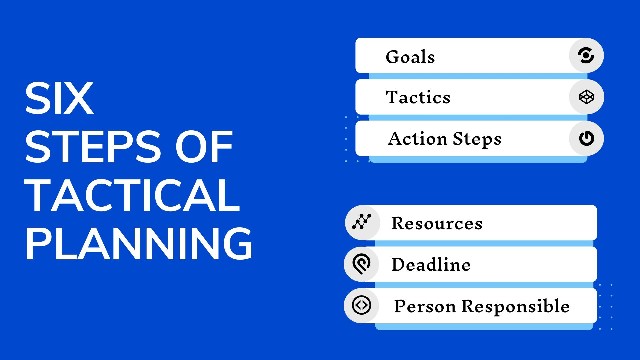Definition: Tactical planning is short term planning which takes into account the current operations of an organization. In this, you will be creating a strategic plan by outlining the general objectives.
The term can be used for the planning of a few days, weeks or months depending on the type of business model and pace of change required.
Tactical plannings is used by managers to fulfill the short term goals of an organization. These short term goals are further set by action plans which aim to achieve the long term strategic goals of the organization.
In this post, we will dive deep into the concepts associated with Tactical Plannings, and understand what it is, how to do tactical plannings, and what some of the key examples of tactical plannings are. So, without any further ado, let us get started.
Table of Contents
What is Tactical Planning ?
Strategic plans are broken down into smaller distinct projects of shorter periods in tactical plannings.
The time horizon of tactical plans is shorter, and independent functions in the company can do the execution. Therefore tactical plannings is highly concerned by middle-level management of the organization. The major areas where tactical plans are developed are marketing, production, finance, human resource, plants, etc.
Tactical plans divide strategic plans into smaller plans in specific areas of the organization.
The functionality and responsibility can be thus transferred to further lower levels of departments to fulfill their concerned parts of the plan. The essential parts of work in a plan are what, when and how to execute. It is done to translate the day-to-day objectives into quantifiable tasks smoothly.
Importance of Tactical Plans
Tactical plannings is a crucial part of the business.
It is not the same as operational plans and strategic plans. The short-term outcomes are targeted in real-time and shorter spans. Tactical plans executed in an adept manner assist businesses to excel within the respective markets.
Tactic plans are usually flexible and carry lesser risk to fail than that of strategic plans.
Strategic plans tend to do undoable harm to the company in case of failure. The tactical plans, on the other hand, can be changed from time to time. Thus they do less harm to the company than strategic plans, if gone wrong.
Once the requirements of the company for the next 5 or 10 years are determined, the next step is to determine how each functional area will contribute to achieving these strategic goals. Then, medium-term business goals are identified.
Tactical plans is a set of actions to be undertaken within the next 1-3 years. These actions must be aligned with the strategic plan of the business.
Let’s assume one of the company’s strategic goals is to expand its business from the North to the Northeast.
Now one must question what kind of action plan must be followed to achieve this goal.
First, increase production levels so that it meets overall demand; at the back end, hire a team of local salespeople.
Based on these sets of actions, indicators are also decided at the tactical level, which allows the company to measure and monitor the company’s performance.
With a tactical level that has been meeting the goals and is aligned with the strategy, there is an excellent chance of accomplishing the more significant goals of the organization.
Let us now have a competitive analysis of strategic planning and tactical planns-
Strategic vs. Tactical
Strategic planning focuses on the big-picture scenarios and in the long term. It generally involves market penetration, company brand and the structure built around the strategy. Strategic planning lays out broad goals for the long-term that a business wants to achieve. The operational plans are focused on the day to day processes. It generally involves the process in communication, manufacturing and other operations necessary for the business to run.
In the tactical plannings, the business responds to immediate requirements. For example, a company requires differentiating itself from the competition by offering a more customized and premium service at a lower price. It can be used as a tactical advantage against competitors when seeking a contract. Tactical plannings lays out the short-term actions and plans required to achieve the goals outlined in the strategic policy.
Strategic planning provides a picture of how to reach a goal, whereas, in tactical plannings, the steps to achieve that goal are defined.
Strategic plans are typically made at the beginning of a year, quarter, or month. It is because the goals set are more general and are evaluated over a more extended period.
After the strategic planning is done, tactical plans are made.
Tactical plans are a set of actions that can be reviewed frequently daily, weekly, monthly, or whenever required.
Upper-level managers generally do strategic planning. Since upper-level managers have a better grasp and understanding of organization due to experience and knowledge, they are considered more capable of making strategic plans.
On the other hand, mid-level and lower-level managers have a better understanding of routine activities; they make tactical plans.
Strategic plans require more effort than tactical plans.
It is because the tactical plans are based on day to day activities which are easy to foresee. On the other hand, strategic plans are based on long terms which makes them a bit difficult to gather.
Strategic plans give a general overview of the required scenarios to be achieved (based on the future predictions) and therefore less detailed.
Tactical plans are based on circumstances existing within the organization and are therefore more accurate.
After being aware of significant differences in Tactical Plannings and Strategic Planning, the next thing that you need to understand is the ways through which your tactical plans can be implemented. So, let us have a look upon that here and now-
Implementing
Time is an essential factor while devising a plan.
The manager generally assesses an opportunity identified by an employee. Various factors such as labor, time and capital required are then evaluated, which need to be employed to take advantage of the opportunity.
A plan is then set such that the costs, as mentioned above, are minimized to achieve the given objective.
Once the opportunity is assessed, and the plan is outlined, the execution of the plan becomes a new direction for the management to follow to achieve the desired results. The plan is also reviewed by executives in case required.
Key things you need to consider while doing tactical plannings are-
- The timeline available for accomplishing for a particular goal
- Knowledge about the tools and resources for accomplishing the particular goal
- Particular actions required for accomplishing a particular goal
Now, while doing tactical plannings, it is important that some characteristics are incorporated into your plan. Let us now have a look upon those characteristics as well-
Characteristics
1) Flexibility
Flexibility is an essential characteristic of tactical plans.
It allows the organization to prepare for unanticipated events. The procedures should be adaptable to the required scenarios and conditions of emergencies faced by businesses such as a change in prices, changes in interest rates, economic slowdowns, inflation, and other market conditions.
For example, if a company manufactures automobiles and makes a strategy to increase its production levels in the coming year, then a tactical plan for each manufacturing facility is constructed.
Those tactical plans should be accommodating enough to uncertainties such as a cut in supplies, a strike by employees, failure of machinery, electricity failures, etc.
2) Communication between functions
One functional department should be aware of the tactical plan of the other.
For example, increasing the sales target as a tactical plan of the sales department must be well communicated to the production department.
It will remove the problem of imbalance in demand and supply.
Also, quantitative figures must be disclosed to erase all kinds of discrepancies.
3) Being well prepared for any change
Business environments and markets can change quickly. Tactics must be reviewed timely to act according to the requirements.
You may say that it is also a part of flexibility, but paying special attention upon this characteristic of tactical plannings is quite important in making your plan result driven.
Now, in the next section, we will be covering different steps that can help you in doing immaculate tactical planning. Let us have a look upon those steps-
Six Steps Method
1) Goals
The very first step of tactical planning is goals that should be SMART. The meaning of SMART in Smart Goals are-
- S- specific,
- M- measurable,
- A- achievable,
- R- realistic
- T- time-bound
2) Tactics
Tactics are the strategies and set of actions you are going to use to achieve the goal defined above in the first step. These are not the actual tasks you will perform, but the kinds of jobs you will be doing to reach the goal.
3) Action Steps
Action steps are the tasks you will schedule to accomplish the above-defined tactics. These have a specific date of completion.
It can be thought of as building your “to-do list” to make sure those tactics are achieved.
4) Resources
In this step, the necessary resources for the above tasks are evaluated. It gives the manager a fair idea of what is required and when. The manager can determine the total cost of the plan in terms of labor, capital and time requested.
Resources can include materials, financial resources, new employees, software, current employees, equipment, and outsourcing work.
5) Deadline
In the next step, the time duration required to accomplish each task is evaluated. Based on this, the periods are decided. It is an essential step since without time constraint a lot of extra resources would be wasted on the tasks.
6) Person Responsible
In this step, it is figured out who will do what job. In this step, you will be finding out the right individual or team for performing the task as per the tactical planning.
Let us now understand the concepts of tactical planning with some examples-
Examples
1) Coca-Cola Example
Coca-Cola bought many independent bottlers and a new organization, Coca-Cola Enterprise was formed.
It was done to counter the threat of restlessness among the bottlers due to environmental issues and to strengthen the company’s market position.
Increasing the firm’s market position was the strategic plan made by the firm’s top managers.
Buying several bottles was a tactical plan of the company, which helped them to keep control of the market while earning millions as profit.
2) Walt Disney Example
Walt Disney Company’s managers developed a strategic plan to encourage growth in foreign markets and profits.
The tactical plan for this was to expand the cable Disney Channel into more and more foreign markets. Another plan was to develop the Disney theme park near Hong Kong.
These were the two tactical plans with the overall strategy to grow in profits and as well as in several foreign countries.
Tactical Planning Wrap Up!
For accomplishing different business and individual objectives or goals, the proper combination of strategic planning and tactical planning is one of the most significant factors.
Tactical plans help teams in having clearly defined steps to accomplish goals in real-time via short term outcomes.
What are your thoughts about the importance of tactical planning in accomplishing different business objectives? Share your views with us in the comments below.
Thank you for reading our article about strategic tacticals
Liked this post? Check out the complete series on Strategy




Perfect